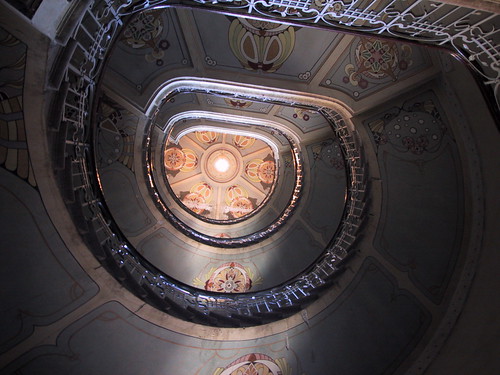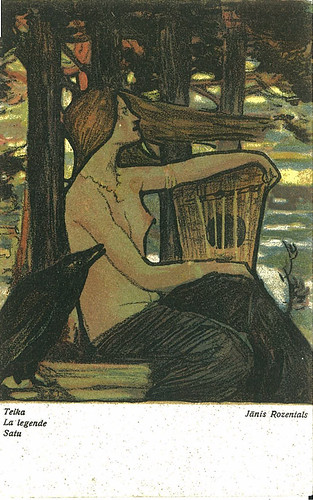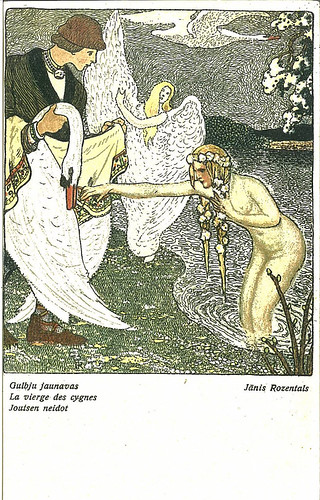I first visited Riga in 2005. One of my must see items was the Latvian National Museum of Art. Unfortunately most of the rooms were closed to allow the collection to be re-hung. I returned to Riga in March this year and found the entire museum closed for reconstruction until June 2015, incidentally missing Riga's year as European Capital of Culture next year. Maybe next time...
I was anxious to see the museum's collection for a number of reasons - the collection of works by the avant-garde Riga Artists Group that was active from 1920-1940; the symbolist works of Latvian heroes including Vilhelms Purvitis and Rihards Zarins and the expressionist works of Jazeps Grosvalds. Well, it was not to be, but I still saw some great art from these genres whilst in the city including from Latvia's best known artist from the turn of the century - symbolist and art nouveau painter, Janis Rozentals.
Symbolism was a style that developed at the end of the nineteenth century, originating in France, Belgium and Russia. The style was adopted by writers, musicians, the theatre and philosophers as well as by visual artists. In painting the style was to some extent a revival of the romantic tradition and some of its more mystical elements. The style had practitioners in many countries - the Armenian Matiros Saryan, Russian Mikhail Vrubel, Norwegian Edvard Munch and Dutchman Jan Toorop. The style varied between artists although most made use of mythological and dream imagery.
Symbolism was a style that developed at the end of the nineteenth century, originating in France, Belgium and Russia. The style was adopted by writers, musicians, the theatre and philosophers as well as by visual artists. In painting the style was to some extent a revival of the romantic tradition and some of its more mystical elements. The style had practitioners in many countries - the Armenian Matiros Saryan, Russian Mikhail Vrubel, Norwegian Edvard Munch and Dutchman Jan Toorop. The style varied between artists although most made use of mythological and dream imagery.
There is a small museum to Rozentals in his former apartment at Alberta Iela 12-9. The apartment is located on the top floor of a renovated art nouveau building, the ground floor of which is home to a small Museum of Art Nouveau with reconstructed rooms from the turn of the twentieth century. The Rozentals museum has a couple of pictures of the artist on view, some of his furniture and artists paraphernalia but is a bit thin on exhibits. Its still worth a visit, not least for the staggeringly beautiful staircase but also to get an idea of the environment that Rozentals would have worked in during those creative and turbulent years at the beginning of the twentieth century.
Rozentals was born in 1866, the son of a blacksmith and was educated at an elementary school in Saldus. At the age of 15 he left for Riga before being accepted at the St. Petersburg Academy of Art where he graduated in 1894 with a first class degree. Rozentals was inspired by the Latvian countryside and its people and returned often to work there. In 1899 he acquired the plot of land where the museum to his name now stands, whilst in 1902 he met the Finnish singer, Elli Forselli, marrying her just three months later in February 1903. Together they had three children but their happiness was to be short lived. The First World War interrupted their family life and in 1915 they moved to Finland. Rozentals died suddenly in December 1916, at fifty years of age. He was buried in Helsinki but was later re-buried in Latvia where an art high school is named after him.
His oeuvre was wide and included drawing and painting, portraits and landscapes as well as works inspired by biblical themes and by the Latvian countryside. He also produced altar pieces for churches, designed book and magazine covers, theatre sets and applied graphic art. However, painting was his preferred form of expression and it is for his symbolist/ art nouveau style works that he is best known. The most prominent of these are the works he produced for the decorative frieze on the Riga Latvian Society building of 1910, consisting of seven compositions reflecting the main activities of the society. These can still be seen from the street.
During the time he spent in his wife's homeland, Rozentals was influenced by the work of Finnish artists Akseli Gallen-Kallela and his devotion to the cause of Finnish nationalism. He became enchanted with Finnish culture and significantly influenced in this by his wife, became knowledgeable enough to write on the subject. This influence is reflected in the Riga Latvian Society frieze but also in our subject's participation in the Latvian national movement as a signatory of the "Demand of the Latvian intelligentsia for civil rights in Latvia" and a longing for freedom from Tsarist Russia.
Much of his work shows folkloric influences, including Legende and La vierge des cygnes (pictured below) and Small Hours from 1905 which depicts a family of devils rushing back to hell as the cock crows for a third time. Devils appear in many Latvian folktales but usually as incompetent figures of fun, easily fooled by the clever peasants. The symbolists made extensive use of mythological and dream imagery and these works are particular examples of that.
As well as symbolist paintings, Rozentals also produced art nouveau style works. One of his most well known is Princess and monkey, which he exhibited at the Munich Secession of 1913. The painting includes various classic art nouveau features including the s-shaped female form, the ornamental carpet in the background, the thickly ringleted hair of the princess, her jewellery and the flow of her dress. This picture, which would not look out of place in an exhibition of Austrian secessionist art from the same period, demonstrates the interest in the east that was prevalent amongst many artists of this genre, as well as echoing the folkloric approach of Gallen-Kallela.
Rozentals' versatility can be seen by comparing the mystical imagery of the Princess and monkey with the symbolic lithograph Archer, pictured below. Produced in 1914, this may well have been influenced by the events then unfolding across Europe that led to the First World War and ironically to a short period of the much longed for Latvian independence which Rozentals would not live to see.
I have never understood why he is not better and more widely known - perhaps the long period of Soviet occupation meant that his work and that of his Latvian contemporaries fell from view. On the other hand he may have been lucky not to have been working during the Soviet period given the suppression of individualism, the strict "rules" of socialist realism and the terrible fate of many leading artists. I know of few publications detailing more of his life and work, but the art nouveau shop opposite the apartment building that houses his museum sells postcards of some of his works together with a small but well illustrated book about his life. The National Museum of Art of Luxembourg produced an excellent catalogue in English and French for its exhibition The Age of Symbolism in Latvia, and this can sometimes be found on Amazon.
 |
| Princess and monkey, Janis Rozentals, 1913 |
 |
| Archer - poster by Janis Rozentals, 1914 |



No comments:
Post a Comment